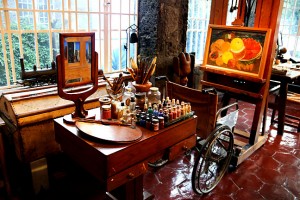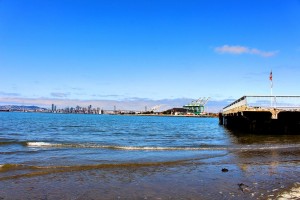Mexico (Ana)

I went to visit La Casa Azul – Museo Frida Kahlo (The Blue House – Frida Kahlo Museum) in the Coyoacan section of Mexico City. Frida Kahlo lived in this house most of her life, it’s where she was born and where she died. Her father, Guillermo Kahlo, built the house in 1904. You get a glimpse into her life including her studio, bed, wheelchair, art collections, family photos and pages from her personal journals. In the center of the garden, you can watch a video collage of Frida’s life including footage of her painting. Kahlo contracted polio at the age of six, which left her right leg smaller than her left. At the age of 18 Sept. 17, 1925, Kahlo was riding in a bus that collided with a trolley car which caused her several injuries including a broken spinal column, a broken collarbone, broken ribs, a broken pelvis, 11 fractures in her right leg, a crushed and dislocated right foot and a dislocated shoulder. An iron handrail pierced her abdomen and her uterus. Because of this she was unable to bear children.
She married world-renowned Mexican artist Diego Rivera at 22. She described him as the “second accident” in her life. The pain from her accident and tumultuous marriage to Diego can be felt in her work and in her words. It also influenced her fashion which I got to experience in the temporary exhibit ending this month, “Las apariencias engañan: los vestidos de Frida Kahlo”. Kahlo wore long dresses and platform shoes to hide the difference in length and width of her legs. She also painted collages on her plaster corsets, which she had to wear because her spine was too weak to support itself. Her fashion has influenced and continues to influence designers around the world including Ricardo Tisci and Jean Paul Gaultier. Some of her quotes are written on the walls in the house, “Pies para qué los quiero si tengo alas pa’ volar” (“Feet, what do I need them for if I have wings to fly”). The Museo Frida Kahlo is located on Calle Londres No. 247 at the corner of Allende in the Colonia Del Carmen Coyoacan area of Mexico City. If you want to take pictures you have to pay an extra fee on top of admission. It’s well worth it and only comes out to about $10 altogether.

A 6.5 hour bus ride 300 miles south of Mexico City brings you to the beautiful town of Oaxaca. It’s listed as one of the safest Mexican tourist destinations you could choose. Designated a World Heritage Site by UNESCO in 1987, you’ll be sure to fall in love with its architecture, food and people. You’ll want to make sure to visit one of the markets where you can get souvenirs, the drink of choice Mezcal and all the ingredients to make tacos de chapulines (grasshoppers). I thought the chapulines were good. They tasted as if they had been marinated with vinegar or lime but still managed to be crunchy. I made a taco out of them with cheese and avocado. There are several money exchange locations, street vendors and tour businesses to make your stay pleasant and effortless. The tour I took included Arbol del Tule, Mitla, Teotitlan del Valle, Hierve el Agua and a Mezcal distillery.
Arbol de Tule is located in the town center of Santa María del Tule and is believed to have the stoutest trunk of any tree in the world. Mitla is the second most important ruins in Zapotec culture as it served as the main religious center. It’s one of the most well-preserved archeological sites in Oaxaca Valley thanks to its dry climate. Teotitlan del Valle is a weaving village that goes back to pre-hispanic times. You’ll learn about how dyes are made, how the yarn is formed and how the design is created utilizing a loom. Hierve el Agua has a “waterfall” appearance created by freshwater springs that have been over-saturated with calcium carbonate and other minerals.

I visited during a cloudy day, but patience gave me a glimpse of the fascinating formations. There are also small pools where one can go swimming. The final leg of the tour brought us to a Mezcal distillery. They provided us a history of how Mezcal is made and several tastings to encourage us to open our wallets.
The Bay Area (Kim)
I drove up to the Bay Area to attend the Spin Academy at Petaluma, Calif. After an eight hour drive, I arrived in Oakland and decided to stay the night. I was awakened by a 6.0 magnitude

earthquake at 3:20 a.m. It was the largest earthquake in 25 years. When I drove around Oakland the next day, I didn’t see any damage. I initially planned to go to the Jack London Square Farmer’s Market but ended up getting lost and “found” Oakland’s Chinatown. I walked around the 27th Annual Chinatown StreetFest’s celebration of the Year of the Horse. With more than 200 booths taking over 10 blocks, there was a lot of merchandise to browse. I bought a Catwoman Lego to add to my collection of fierce heroines. I passed by a restaurant that had a fairly long line, I decided to join. I figured if there’s that many people waiting, it must be good. I wasn’t disappointed. It was one of the most delicious meals I’ve tasted. I enjoyed the fried shrimp and dumplings at the Middle Harbor Shoreline. The 38-acre park offered an incredible view of the city of San Francisco. It was one of those rare days when the skyline was not covered with fog.

After I finished my lunch, I drove to Napa Valley. The structural damages from the earthquake were visible throughout the small downtown area. There were news cameras set up in front of the buildings that were affected. Tourists taking photographs of rubble piled on top of cars and buildings with the roofs hanging off the sides. Many businesses were closed and trucks were cleaning up the streets. It was reported that at least 172 people were treated for injuries.
The next day, I drove to Fort Bragg with the intention of seeing the Glass Beach. Unfortunately, it’s closed until Nov. 30. The Medocino Coast is very beautiful and I ended up spending over an hour just walking on the beach and taking photographs of the ocean. After the beach, I spent the day at the beautiful Rohnert Park Cotati Regional Library to do some work. Not a bad place to work. It’s a very open and sunny space with easy access to local restaurants and juice bars.

Prior to heading to the Spin Academy Training Aug. 26, I brought lunch and spent an hour just enjoying the sun at the Steamer Landing Park. Adjacent to Petaluma’s downtown area, the 1.93 acre park has beautiful trails and a historic livery stable. The drive to Walker Creek Ranch Outdoor School and Conference Center was a short and confusing one. It’s amazing how dependent I have become on technology. I absolutely felt lost and disoriented without the navigation on my phone even though there’s only one road leading to the ranch. The ranch had 20 miles of hiking trails, a four acre pond, an organic garden and a low-ropes challenge course.
I spent four days with 50 fellow social justice communicators from all over the country who were selected to participate in training on how to communicate for change. It was an inspiring and motivating experience to be surrounded by other progressive communicators. It re-energized my commitment to social justice and contributing to creating change in our communities.











